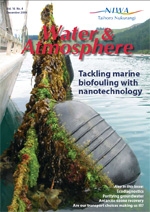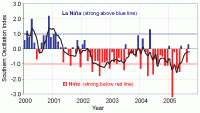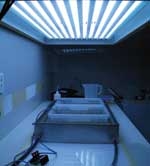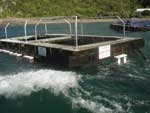As the world seeks a non-toxic defence against costly biofouling, NIWA and its collaborators are on the track of a new coating for hulls, pilings, and submerged equipment. Craig Depree takes a close look at a nano-solution.
PDF of this article (196 KB)




Marine biofouling is the unwanted growth of organisms on submerged man-made surfaces. These can be anything from mobile surfaces like ship hulls and aquaculture equipment to fixed structures such as water intakes,wharf and pier pilings, and oil rigs. Biofouling can reduce inflows, increase abrasion, wear, and corrosion, and decrease buoyancy. Critically for ships, hull biofouling increases drag, and can blow out fuel consumption by as much as 40%.
The fouling organisms that grow on these structures are diverse. To address this biodiversity, most conventional antifouling (AF) coatings have contained a cocktail of toxic biocides; however, many of these have been banned because of concerns regarding their persistence, accumulation, and non-target toxicity in the environment. Some historic examples of banned AF biocides are organo-mercury, lead, arsenic, and DDT. Now a ban on tributyl tin (TBT), which was used on 80% of the world’s shipping fleet, has come into effect. The global ban on TBT as an antifouling biocide has led to copper based formulations becoming the dominant AF technology; it’s estimated that these coatings contribute 15,000 tonnes of copper to the marine environment each year.
The search for copper-free alternatives
Faced with the potential environmental impacts of copper and associated organic biocides, researchers around the world are trying to develop new technologies that can provide effective AF performance without releasing toxic biocides intothe marine environment. Currently, the only commercially available non-toxic AF coatings are those based on ‘nonstick’ technology: the surface still fouls under static conditions but, due to relatively weak adhesion, the fouling is dislodged when the boat is moving at speed. Accordingly, the usefulness of these non-stick coatings is limited to high-speed vessels,and no use at all for large commercial vessels and stationary objects.
Nanoparticles: a potential solution?
The unique properties of nanoparticles may provide a novel pathway to develop non-toxic surfaces for a broad spectrum of marine applications. Nanoparticles are sized between 1 and 100 nm (nanometres; 1 nm = 0.000000001 metre = 1 billionth of a metre). That means you could fit about 75,000,000 of the largest nanoparticles on this bullet point •.
Nanoparticles are of interest as they often behave differently to larger particles of the same material. This is partly because the larger surface-area-to-volume ratio enables unique properties of the ‘surface atoms’ to dominate over the ‘bulk material’.
NIWA and our collaborators – Industrial Research Ltd, James Cook University, ESP Company Ltd, and Altex Coatings – are using nanotechnology to find a solution for biofouling. We’re developing and evaluating the effectiveness of photocatalytic coatings containing a semi-conducting oxide, namely titanium dioxide (TiO2).
The ‘mode of action’ of this ‘nano-solution’ is based on TiO2 being a semiconductor: when it’s exposed to ultraviolet (UV) light, an electron moves to a higher energy level in the TiO2 particle (the photocatalytic reaction). This process yields negatively charged electrons (e-) and positively charged holes (h+), which can react to form very strong oxidants on the surface that break down any attached organic matter.
Titanium dioxide is a naturally occurring mineral that is considered harmless in itself, and the oxidants formed at the TiO2 surface during photocatalysis are very short-lived and pose no further threat to the environment.
This photocatalysis is the basis for existing technologies that use TiO2 for self-cleaning windows and coatings, air purification, antibacterial surfaces, and wastewater treatment. However, we saw an opportunity to apply the photocatalytic properties of semi-conducting oxides to submerged AF applications, and test their effectiveness against common fouling organisms such as algae, bryozoans, and barnacles.
Testing the power of titanium dioxide
In the first year of our project we have set up the necessary UV-testing apparatus and are developing suitable methods forapplying photocatalytic TiO2 surfaces to the glassware used in biofouling assays. In addition to determining proof of principle with laboratory-based testing, we will be evaluating the effect that duration, timing, and intensity of UV exposure have on efficacy to determine how these surfaces may behave in the real world.
We’ve already had some very promising results, with TiO2-treated surfaces inhibiting fouling both from diatoms and bryozoan larvae. The latter is of particular interest as there has been no previously reported photocatalytic activity against ‘macro-fouling’ organisms (at 300–400 microns, bryozoan larvae fall in this category). In laboratory tests of thin TiO2 films fused onto petri dishes, we’ve observed that after 24 hours (with 14 hours of light and 10 of dark) more than 80% of thelarvae died prior to settlement. More importantly, however, is that after 48 hours none of the remaining larvae that manage to attach develop into viable juveniles.
An important question for this research is whether there is enough UV light under the water to activate the photocatalytic TiO2 surface, particularly on shaded parts of the hull. Whilethe intended application for these coatings is small leisure craft with a hull depth of about 2.5 m, we’re also modifying the TiO2 chemically so it can be activated by visible light (in the blue region of the spectrum); this should improve activity under low-light conditions. Finally, in addition to laboratory testing, we‘re incorporating photocatalytic nanoparticles into commercially relevant paint formulations produced by our industry partners, and these are being evaluated in long-term field trials.
Solar-powered antifouling
- Controlling biofouling on boat hulls and aquaculture structures costs billions each year.
- New technologies aim to deter biofouling without releasing harmful chemicals into the environment.
- Photocatalytic surfaces with nano-sized particles of TiO2 are a promising non-toxic solution to biofouling.
Dr Craig Depree is an organic chemist working at NIWA in Hamilton.
The ‘Novel Antifouling Photocatalytic Nanotechnologies’ programme is funded by the Foundation for Research, Science and Technology. NIWA’s research partners in this programme are Industrial Research Ltd, James Cook University, ESP Company Ltd, and Altex Coatings.
Teachers’ resource for NCEA Achievement Standards or Unit Standards: Biology Level 3 US6320, AS90714 Chemistry Level 3 US6340
